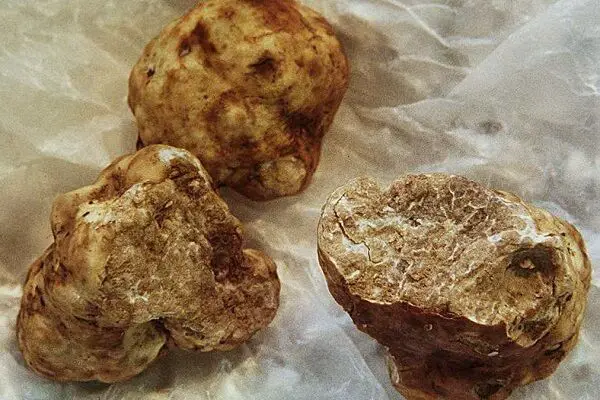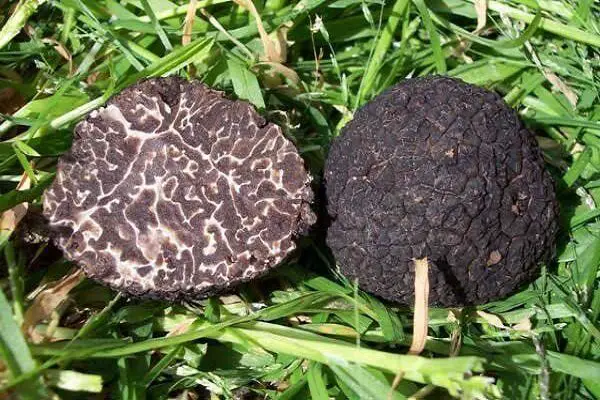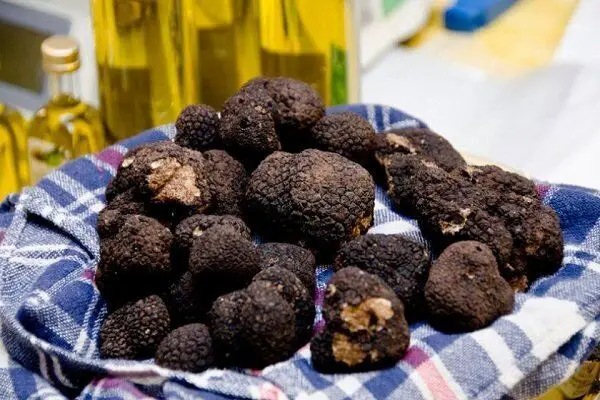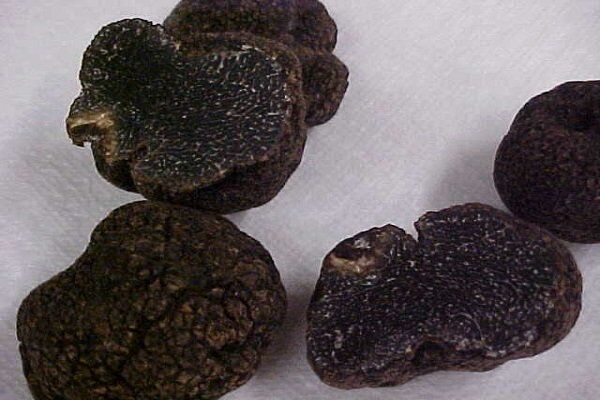Growing truffles is a costly business, as planting material is expensive, and the crop is harvested after 3-5 years. But such efforts are fully justified by the price of finished products. Agricultural technology is distinguished by increased requirements mushrooms prefer special conditions for growing in different places.

Table of Contents
Characteristics of truffles Mushroom
The Latin name for truffle is tuber. The fungus belongs to the marsupial class of the truffle family. The peculiarity is the mycotic type, therefore it grows when it enters into symbiosis with the roots of trees (the optimal species is oak) at a depth of at least 15 cm. The vegetative body is called the mycelium.
Appearance of truffles Mushroom:
- shape – spherical, tuberous (like a walnut, potato);
- the outer shell is smooth and embossed, with a cracking surface, growths such as warts;
- peel color – depending on the variety, white, gray, black, chocolate;
- pulp – white, gray, yellowish-brown;
- structure – marble with streaks of white or red;
- size – minimum 2.5 cm, maximum 20;
- the weight of one fruit is from 20 to 200–250 g, but there are specimens of 800–900 g or more.
Other Features of truffles:
- fruiting – 25 years;
- the shelf life of the truffle after cutting is 4 days;
- one nest contains from 5 to 8 bodies;
- taste and aroma – specific, with notes of chocolate, seeds, nuts, spirits, mushrooms, herbs, etc.;
- valuable varieties for consumption – Piedmontese, Perigord, winter;
- the growing season is 3–5 years (it takes 5–8 months to form a fruit);
- mycelium – in appearance it resembles a bunch of fluff, cotton wool;
- the structure of the nest is fibrous (thread-hyphae);
- favorite soil – deciduous, calcareous, mixed, loose.
During growth, the upper part of the mycelium is covered with buds, from which fruiting bodies are formed.
What kind of truffles can you eat?
About 30 varieties of truffles are known in the world, but not all of them are suitable for eating. Cooks distinguish several main types of tuber, which are usually grown on farms.
Black summer

In Latin, it is called Tuber aestivum. Differs in such indicators:
- size – from 2.5 to 10 cm;
- color – black with a brown or bluish tint;
- pulp – dense at a young age, loose as it grows;
- the color of the inner body is from white to brown;
- palatability – sweetish, sharply nutty.
Black winter
Scientific name Tuber brumale. Mushroom has the following characteristics:

- diameter – from 8 to 15 cm;
- shade – at the beginning of growth red with purple, when ripe – black;
- flesh – color changes as it matures: white, gray, gray-violet;
- taste – with a musky tint.
Feature – white and yellow-brown streaks in the pulp of the fruiting body. It grows in Ukraine, Russia, Italy, France, Switzerland. The ripening period is from November to March.
You can Growing Black Truffles Mushroom with proper care and conditions.
Perigord truffle (French)

Variety of black truffles. Tuber melanosporum is recognized by the following data:
- parameters – from 3 to 9 cm;
- colors – initially red-brown, in maturity – black coal, and when crushed it acquires a rusty tint;
- the inside of the fruiting body is elastic, gray or pink-brown, the pattern in the section is red or white;
- taste – a slight bitterness is felt.
Most often found in Spain, Italy, France. Harvesting starts in November and ends in March.
Chinese

Asian representative of the delicacy. Tuber indicum has the following characteristics:
- diameter – maximum 9 cm;
- shade – dark gray, black when overripe;
- vegetative body – dark brown;
- aroma is almost non-existent.
It is actively grown in China. Fruits during the winter. Feature – very hard pulp and surface, so it is difficult to chew.
Oregon truffles
The mushroom belongs to the white variety. Differs in the following characteristics:
- parameters – up to 5–7 cm;
- color – light brown;
- the pulp is golden with snow-white streaks;
- Taste is herbaceous and fruity.

Grows exclusively in Oregon and America. Artificially grown in Russia and Europe. Prefers upper layers of soil with coniferous foliage (other types of truffles do not grow in needles).
Conditions and features of Growing Truffles at home
This is the most expensive mushroom, which is artificially grown in almost all countries of the world, but most of all in France.
This year, for the first time, a truffle farm was opened in the Krasnodar Territory. Mycelium was brought along with oak seedlings from France. The mushroom grower grew mushrooms in the open field, as the climatic conditions of the region allow (truffle prefers a temperature of + 22 … + 25 ° C).
Mycelium is planted in the basement or greenhouses. They are equipped with heaters for year-round maintenance of optimal temperatures.
Steps for Growing Truffles at home
Ordinary mushrooms grow by parasitizing on the root system of plants, and the truffle develops due to the entry into symbiosis with the roots. He needs organics, which he extracts from trees. In exchange, the fungus shares moisture released from the vegetative body.
Additionally, tuber repels harmful fungi and mold from the root system.
Cultivation of scarce mushrooms in the conditions of personal subsidiary plots is associated with a lot of subtleties. The rules of agricultural technology will need to be observed very precisely. Otherwise, all the work will be in vain.
Location selection
For growing truffles, especially if you plan to plant in open ground, consider the following factors:
- the maximum slope of the surface is 10–13 °, it is even better that it is even;
- other mushrooms should not be grown nearby;
- tuber does not tolerate weeds;
- soil fertility 30–40 cm deep;
- oaks, hazel, beech, hornbeam, orange, lemon, tangerine trees, sequoia, olive should be present on the site;
- you can not plant where conifers grow or previously grew (fir, spruce, pine, thuja), willow, chestnut, poplar;
- the distance between plants is at least 5 m.
About 5-7 months before planting the mycelium, prepare the soil.
Truffles Soil preparation
There is a main requirement for the soil – its acidity is 7-8 pH. The indicator is provided by the land with rotted fallen leaves. If you are planting truffles in a basement, greenhouse, or open garden, follow these guidelines:
- Priming. It should not contain spores of other fungi and pathogens. Therefore, disinfect the ground first. To do this, use a steam generator or oven.
- Sand and sawdust. The wood shavings must belong to a species of wood that is favorable for growing truffles. The sand acts as a soil loosener.
- Fallen leaves. Disinfect in any way.
- Minerals. Add more calcium to the soil mixture to form a vegetative body. Nitrogen, humus, sulfur, iron, alkali are needed.
Selection of planting material for Growing Truffles at home
The main material for planting is mycelium. It is sold in specialized retail outlets and online stores. It is better to give preference to licensed official sources.
There are 2 types for sale:
- live – stored no more than 6 months;
- dry – shelf life is unlimited.
The mother culture is distributed on a grain basis, from which it is necessary to grow mycelium. It is possible to buy mycelium embedded in tree seedlings.
For better mycelium formation, buy sprouts, not ready-made seedlings.
The duration of infection is 11–13 months, therefore, to save time, mushroom pickers prefer mycelium already planted on grain or sprouts.
mycelium for growing Truffles
Mycelium can be germinated in 2 ways. The first involves direct planting in the garden, the second – on seedlings.
mycelium germination process:
- Select trees of the desired species that are at least 5-6 years old.
- Dig holes around them. Depth – 20-25 cm, diameter – 8-12 cm.
- Line half of the hole with prepared soil.
- Sprinkle peat and mycelium on top (the exact amount of planting material for one hole is indicated on the packaging of a particular variety).
- Fill the remaining space with the same prepared soil mixture.
- Pack very tightly.
- Fill with water at the rate of 10 liters per recess.
- Cover the landing site with any natural material at hand – moss, leaves, dry grass, branches.
- Pour settled water again, but not into the hole, but around it.
You will get the first harvest in 3-4 years. Landing is carried out in late May-early June.
mycelium germination with spores of seedlings:
- Take the oak sprout.
- Sprinkle the roots with mycelium and peat.
- Place in a plastic bag for 15-20 days, leave in a warm place.
- Transfer to a sterile room.
- After 12-16 months, transplant to a permanent place. In this case, the size of the mushrooms should reach 18–20 cm.
It is acceptable to use freshly harvested tree bark. The recipe is simple:
- Grind wood raw materials.
- Mix with spores and peat, put in plastic bags or 3-liter jars.
- Tie tightly or cover with a lid. After 3-4 days, make holes. Leave until full germination.
Planting truffle mycelium
Working with finished material. The process of planting mycelium in a permanent place:
- Dig holes to a depth of 75–80 cm.
- Install the seedling, tamp and water.
- Lay mulch around the trunk (radius 40–50 cm, thickness 2–3 cm).
- Cover with foil.
Shelter is removed after 30 days at an air temperature of at least + 23°C.
Truffle care
For the first 24 months, carefully clear the area above the truffles to remove weeds.
What else needs to be done:
- in spring, fluff up the near-stem space, especially when fruiting begins;
- do not allow the soil to dry out – it should be in moderate humidity (for this, do not remove the mulch);
- irrigate with a drip method so that water evenly penetrates to the mushrooms;
- feed with preparations that contain iron, copper, magnesium, zinc and boron;
- fight against the main enemies of truffles – black cockroaches, weevils;
- cut trees in a timely manner so that the sun’s rays and precipitation penetrate under the trunk.
Truffle Pests and protection
Among pests, cockroaches and weevils are dangerous.
How to deal with with truffle bugs:
- do not plant field crops nearby;
- make baits – spread boric acid with honey or sugar on cardboard, place it on the territory of the mycelium;
- buy special chemicals.
The danger of fungal infection with parasites comes from animals (dogs, pigs, hares, etc.).
Harvesting truffles mushroom
The first mushrooms can be collected after 1–2 years, but during this period there are no more than 5–8 fruiting bodies in one hole. After another 3-4 years, you can harvest a full-fledged crop (per 100 sq. M – 9-12 kg).
Only ripe mushrooms are edible. How to determine:
- the earth is raised above the truffle;
- there is a cluster of midges around;
- the grass dries up over the mushroom.
For collection, a small spatula is used, with which gently lift the layer of earth and just as carefully cut the fruiting body with a knife, holding it with the other hand. Do not damage the mycelium and root system of truffles.
3 Places to Grow Truffles at home
3 main places are used for growing truffles- on beds, greenhouse, and basement.
Growing Truffles on beds at home
When planting truffles on the beds, the distance between the trees is maintained according to the scheme 4 x 4 m or 4 x 5 m.
The approximate number of seedlings per 1 ha is 480–500 units. Conditions for growth:
- air temperature at night – + 16–18 ° С, during the day – + 25 ° С;
- soil moisture – 70–80% (mulch is laid to maintain stability);
- seedling planting depth – 70 cm;
- Apply rotted manure once every 2 months – this is necessary for a partner tree;
- treat mulching materials in a weak manganese solution to prevent the development of pathogens.
Immediately after transplanting, cover the seedlings with agro fiber or plastic wrap. Keep doing this until the air temperature stabilizes to the optimum.
Growing Truffles in greenhouse
Tuber mushrooms prefer warmth and are afraid of frost. Build a greenhouse from polycarbonate. It is acceptable to use glass, double polyethylene.
Features of growing truffles in a greenhouse:
- avoid direct sunlight – they kill spores, it is better to use artificial lighting (as an option – hang dark curtains, whitewash the ceiling);
- before wintering, take care of the tightness of the greenhouse structure – draft and cold should not penetrate inside;
- install heaters to maintain the temperature during the day + 23–25 ° С, at night + 15 ° С;
- install a ventilation system – it maintains the level of humidity, does not allow mold to form;
- water by spraying – add water when a thin crust begins to form on the surface of the soil.
Growing Truffles in basement at home
To obtain a decent harvest, special attention is paid to the room. His environment should be as natural as possible. What to do – step by step instructions:
- Fill the floor with concrete mortar, plaster the walls and ceiling.
- Divide the territory into 2 parts – for the cultivation of mycelium and the cultivation of truffles.
- Install shelving (preferably metal-plastic).
- Disinfect. To do this, carry out sulfuric fumigation of the space, whitewash the walls / ceilings with lime, spray all surfaces with chlorophos and ventilate.
- Install a ventilation, exhaust and heating system, supply water, hang lamps, a hydrometer and a thermometer.
Close all openings to the ways with a small-celled mesh to prevent insects from entering. Maintain standard air temperature and humidity (as in other cases).
Storing truffles mushroom
The cut truffle is stored for no more than 4 days. But there are tricks that are used in industrial production:
- do not clean from the soil – it will protect the fruiting body from harmful environmental factors;
- put mushrooms in the refrigerator, which will extend the shelf life;
- shift the fruiting bodies with dry rice, but first wrap them in parchment, which will eliminate the release of moisture.
Growing truffles as a business
Tuber mushrooms are distinguished by the duration of cultivation, but patience and work fully pay off. Average profit margins are 250%. This is due to the high cost of the product and constantly increasing consumer demand.
For the sale of truffles, there are such options:
- elite restaurants / hotels (more often in large cities);
- shopping sites that sell delicacies;
- platforms for business – wholesale is rare, mostly they buy mushrooms by the piece.
After regular customers are found, business development will begin. Searching for clients is carried out in advance. Mushrooms have a short shelf life.
Conclusion
It is quite possible to grow truffles at home. Of course, the agrotechnical process is expensive, complex, and lengthy. But in the end, the work will be crowned with a rich harvest, and the sale of fruiting bodies will return the money invested.
